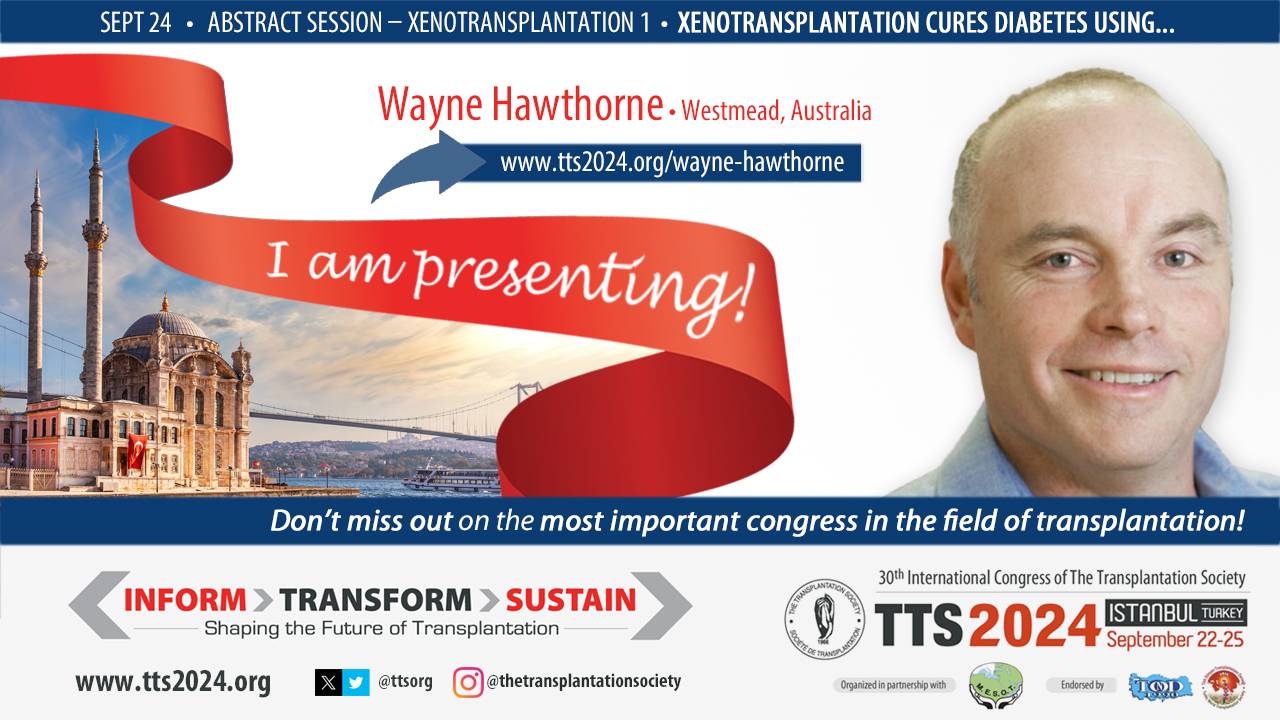
Xenotransplantation cures diabetes using local immunosuppression to protect transgenic porcine neonatal islet cell xenografts in the diabetic baboon model
Wayne Hawthorne1,2, Evelyn Salvaris3, Erin Fuller2, Thanh Le2, Mark Nottle4, Peter J Cowan3,5.
1Surgery, Westmead Hospital, Westmead, Australia; 2Centre for Transplant & Renal Research, Westmead Institute for Medical Research, Sydney, Australia; 3Immunology Research Centre, St. Vincent's Hospital, Melbourne, Australia; 4Medicine, University of Melbourne, Melbourne, Australia; 5Medicine, University of Adelaide, Adelaide, Australia
Background: Our research group has made significant progress in xenotransplantation in the pre-clinical diabetic baboon model. Utilising Transgenic (TG) donor pigs to produce neonatal islet cell clusters (NICC) specifically engineered for islet xenotransplantation into humans, along with a novel immunosuppressive regimen, we have achieved remarkable long-term graft function, with baboon recipients maintaining insulin independence for ~400 days. However, we are developing a protocol that will reduce the need for ongoing systemic immunosuppression to facilitate clinical translation. In our previous studies withdrawal of maintenance immunosuppression eventually led to graft rejection, highlighting the need for further innovative approaches to ensure long-term graft survival without the need for continuous systemic immunosuppression.
Aim: In our pursuit of a sustainable solution, we have been exploring "local" immunosuppression strategies, including the use of genetically encoded secretion of the anti-CD2 monoclonal antibody diliximab by porcine islets. Our proof-of-concept studies in small and large animal models demonstrated promising results, suggesting that this approach could prolong xenograft function without systemic side effects. Building upon this foundation, we have combined multiple transgenes into our TG donor pigs (Anti-CD2-CD55-CD59-HTF-GKO). The aim of this study is to commence testing the efficacy of these engineered islets in our preclinical pig-to-baboon model.
Results: Our first recipient baboon in this series is currently 140 days post-transplant and has had oral immunosuppression ceased and has maintained normal blood sugar levels. Insulin and porcine C-peptide responses to glucose challenge have been demonstrated in IVGTTs. Additionally, a biopsy taken at 112 days post-transplant from the liver demonstrated multiple functional viable islet cells producing significant amounts of insulin, glucagon and somatostatin. Maintenance immunosuppression with anti-CD154 and belatacept will be tapered and withdrawn over the next 6 months.
Discussion: Studies are ongoing, with a second animal in this cohort about to be transplanted. We propose that genetically encoded secretion of anti-CD2 by porcine islets may have a significant protective effect in combination with other transgenes established to be xeno-protective. We aim to demonstrate the efficacy of this modality to be able to move this forward to clinical translation in the near future.
JDRF International.

right-click to download
